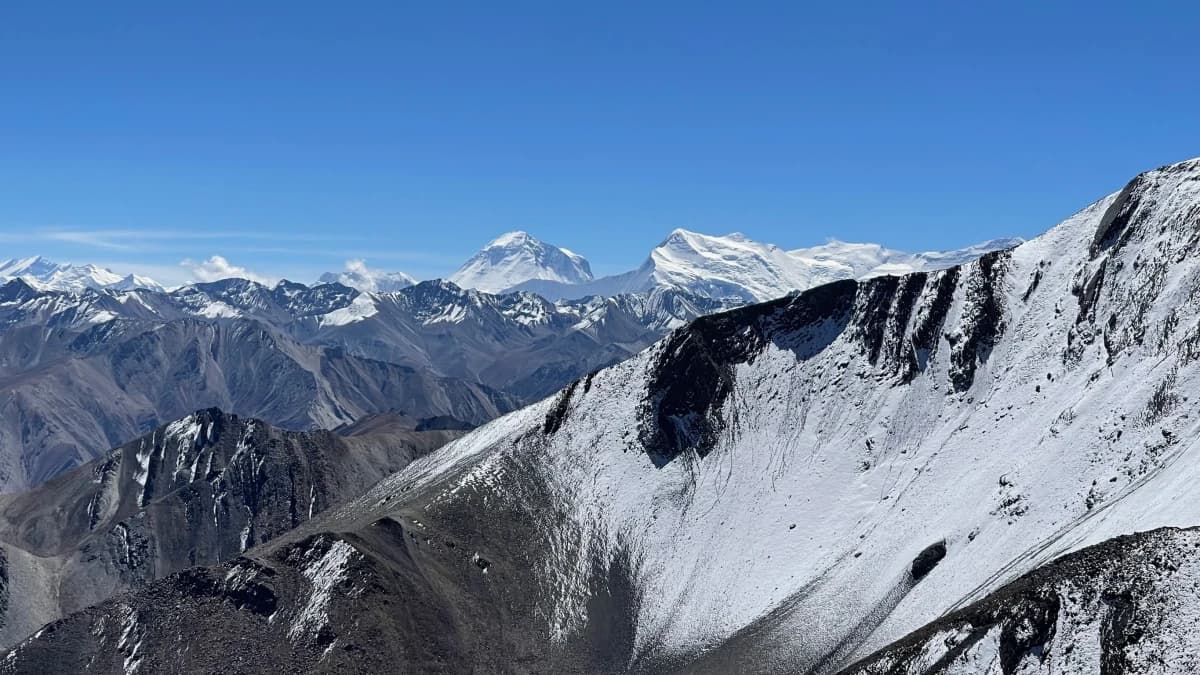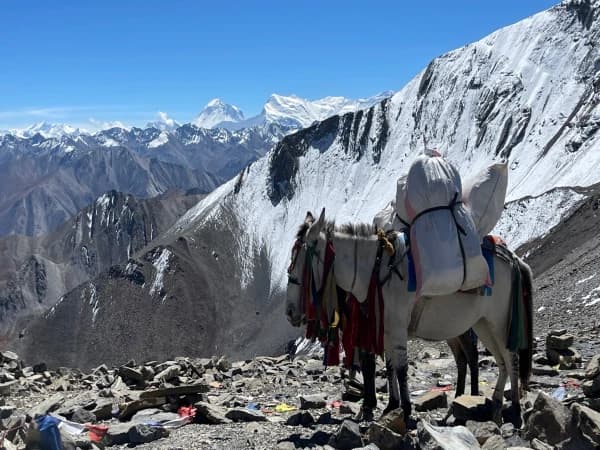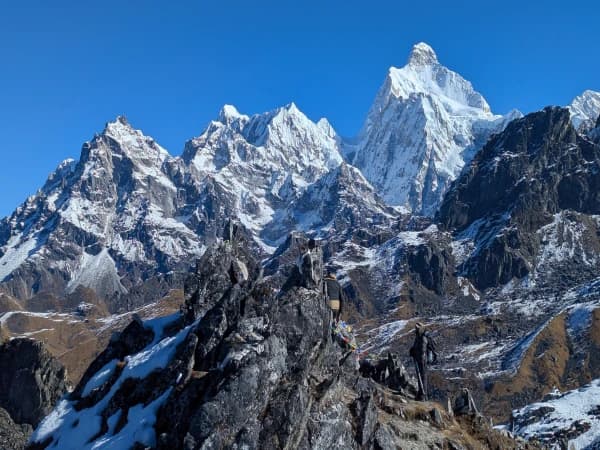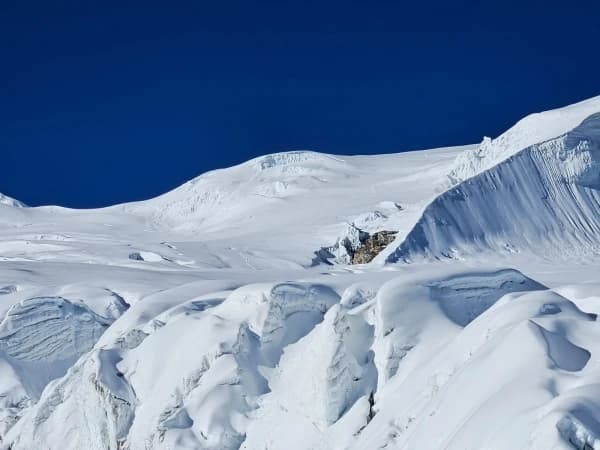Beginners Complete Guide for Necessary Permit, Season and Trek Difficulty to Upper Dolpo
Dolpo trekking region is one of the most isolated and untouched mystical destinations located in northwestern Himalayan region of Nepal. This region is surrounded by rugged mountains and barren landscapes which offers a glimpse into a world where everyday life is still conducted by tradition. Nepal, despite being a popular destination for trekking, Dolpo is highlighted because of its raw beauty, high altitude passes, lakes, and preserved Tibetan culture.
There are two main regions Dolpo is divided into, which are Lower Dolpo and Upper Dolpo. Both have their own unique landscape, difficulty level, and culture they practice. Lower Dolpo compared to Upper Dolpo is more accessible featuring dramatic scenery, traditional villages and offers the stunning view of Shey Phoksundo Lake (Nepal’s deepest and most beautiful alpine lake) besides its remoteness. The trail of Lower Dolpo has lush forests, waterfalls, and remote hamlets, making it an entry point for the trekkers who want to experience the secrets of Dolpo without going for high-altitude areas.
On the other hand, Upper Dolpo trekking is far more demanding and secluded. This region was opened to foreigners only in 1989. Upper Dolpo lies beyond the Dhaulagiri and Kanjiroba ranges which is why trekking in this region is physically and mentally hard and a challenging journey across high passes (Kang La and Num La, above 5,000 meters). This trek requires permits, guides, and careful planning. Don’t you worry, as a result, it rewards adventure with Himalayan wilderness, centuries-old monasteries (Shey Gompa), and encounters with communities that still follow the ancient Bon and Tibetan Buddhist traditions.
Dolpo is known for its remoteness where infrastructure is minimal, lodges are rare. And communication is limited. To reach many villages in Upper Dolpo, people still need to walk for about a week from the nearest road or airport. This might be the reason why the culture and heritage of Dolpo is still preserved along with ecological purity. This means if you are trekking in this region, you must be well prepared and self-reliant. Due to its remoteness, a limited number of visitors visits here, which makes this area so special and remote.
Other than Dolpo, if you’re looking for such a long and remote trek, Kanchenjunga Trek, Nar Phu Valley Trek, and Manaslu Circuit Trek can fit your taste. Kanchenjunga trekking (5,143 m) in Nepal is one of the most challenging treks which is rural and remote where your state of survival is strenuous. Kanchenjunga trek takes around 22 to 26 days making expenses of around USD 1700 to USD 4500 depending on your itinerary, time, and choice of service. Kanchenjunga trek provides cultural interaction with Rai, Limbi, and Sherpa communities immersing into Buddhist, Hindu, and animist traditions. This trek provides breathtaking views of world’s 3rd highest peak, Mount Kanchenjunga, and its diverse natural landscapes, including forest of rhododendrons, glaciers and high-altitude passes.
Another option can be Nar Phu Valley Trekking (5,306m) which is known for the untouched beauty, vibrant Tibetan culture, and stunning mountain views (Mount Annapurna, Dhaulagiri, and Manaslu), high-altitude passes (Kang La Pass and Thorong La Pass), high-altitude villages, and chance to interact with locals. This trek also takes you through ancient monasteries like Tashi Lhakhang Monastery, a 1000 years old monastery. Due to its remoteness, Nar Phu Valley Trek gives a sense of isolation. Another similar restricted area trek that can be done within a short period of time is 16 Days Manaslu Circuit Trek.
Therefore, Dolpo is not just a trek, it is an expedition into one of the most authentic and spiritual regions of Nepal. no matter if you choose Lower or Upper Dolpo, you’ll experience a corner of the Himalayas that feels sacred and timeless. Dolpo Trek Nepal offers an unmatched journey into the hidden heart of the Himalayas.
Dolpo Highlights
- Shey Phoksundo Lake (Nepal’s deepest and most beautiful alpine lake)
- Shey Gompa (800-year-old monastery nestled beneath the sacred Crystal Mountain in Upper Dolpo)
- Tibetan Culture and Bon Traditions
- Remote and Less-Crowded Trails
- High Himalayan Passes (Kang La, 5,360m and Numa La, 5,190m
- Shey Phoksundo National Park
- Traditional Villages like Ringmo, Saldang, and Dho Tarap, untouched by modern development.
- Restricted Region Adventure
- Dramatic Landscapes
- True Wilderness Experience
Where is Dolpo Region in Nepal? Why go for Dolpo Trek?
Dolpo region lies in upper Dolpa district of western Nepal. The north of Dolpo is bordered by China. This region is surrounded by Himalayas including Dhaulagiri (8,167m). Dolpo region is divided into four valleys: Dho (Tarap Valley), Saldang (Nankhang Valley), Tinje (Panzang Valley), and Chharka (Tsharka Valley). A part of this region lies in Shey Phoksundo National Park as well.
Trekking in Dolpo offers a rare and real Himalayan experience that few other trekking regions in Nepal can match. Dolpo remains truly off the beaten path while popular routes like Annapurna Base Camp and Everest Base Camp have been commercialized. The preserved Tibetan culture, unspoiled languages and spiritual depth has made Dolpo region a pull factor for trekkers looking for adventure, solitude and cultural immersion.
Dolo has been popular for its isolation and remoteness that has been tucked behind the Dhaulagiri and Kanjiroba mountain ranges. This region receives a lower number of visitors due to limited accessibility and special permits required. You cannot experience the feeling of being in Dolpo elsewhere, the sense of peace and connection with nature, especially in camping trek without meeting fellow trekkers.
Dolpo is rich in culture. This region is deeply influenced by Tibetan Buddhism and Bon traditions, which are visible in architecture, festivals, monasteries, and lifestyle of local people, being another compelling reason to trek here. While trekking, you’ll pass through villages like Dho Tarap, Saldang, and Ringmo that offer a chance to witness unchanged traditional practices. You’ll feel like stepping into a living museum in Himalayan region of Nepal.
Dolpo is spectacularly diverse from a landscape perspective which takes you through high-altitude passes, deep river gorges, barren plateaus, and lush pine forests. The highlight of the trek, Shep Phoksundo Lake is a pull factor with a dramatic surrounding. Panoramic views of snow-capped mountains, chances to encounter wildlife (Snow leopard, Himalayan blue sheep, Eagles) is what this trek also offers.
Dolpo is an ultimate challenge for adventure lovers and seekers as Dolpo trek is physically demanding, which requires mental strength, and planning, especially in Upper Dolpo. In return, you get once-in-a-lifetime-experience in untouched regions. Trekking in the Dolpo region means going beyond the tourist route and embracing a journey that is both physically and spiritually transformative.
What is the Best Time for Trekking in the Dolpo Region?
As Dolpo lies in the rain shadow region of the Himalayas, this region receives very little rainfall even during monsoon season. But, due to its high altitude and rugged terrain, weather conditions can become extreme. If you want to enjoy clear skies, passable trails, and stable weather, try trekking during late spring to early autumn.
Spring Season (Mar to June) is the best time for Dolpo region trek. The snow from high passes melts down during this season, making routes for passes like Kang La and Num La. During this season, temperatures are warmer in the valleys, wildflowers bloom in the trail, and are quieter before the main trekking crowd heads to another region in Nepal.
Autumn (September to November) is the best trekking season for Dolpo that offers clear mountains, fresh air, and a higher chance to see traditional festivals in the villages, making this season another best season. This is post-monsoon season, when the visibility is best, but nights get starting colder at higher elevations during this season. So, if you’re planning, bring proper gear.
Even though Dolpo receives minimal rainfall, the flights and road transportation may get disrupted during Monsoon season (July to August) making it hard for trekkers to travel during monsoon. But, if you are available for trekking in the Dolpo region only between the months of July to August, it is possible with some experienced trekking agencies even though you are recommended for the best season in Dolpo Trek i. e. Spring and Autumn. Trails in lower elevations are slippery with the possibility of leech. Similarly, weather during winter (December to February) makes the routes inaccessible due to heavy snowfall making the passes closed. Even the locals migrate towards lower elevations during winter.
How Difficult is the Upper Dolpo Trek? Getting Altitude Sickness in Upper Dolpo?
Of course, Upper Dolpo Trek is considered one of the most difficult treks in Nepal, and for good reason. Popular treks like EBC or ABC are also difficult but less in comparison to Dolpo due to commercialization. Trekking in Upper Dolpo requires a high level of physical fitness, mental endurance, and proper planning. The trail is often steep and you’ll walk for long days for about 6 to 9 hours a day passing rocky ridges, barren valleys, and high passes (more than 5,000 meters), making it challenging for trekking.
The attitude and remoteness is a major reason why trekking in Dolpo region is difficult. Trekkers must cross high-altitude passes like Kang La Pass (5,360m) and Num La Pass (5,190m), which is very challenging due to low oxygen levels. Here, proper acclimatization is difficult and altitude sickness becomes a concern. Due to lack of modern infrastructure like no access of roads in most parts, limited access to food and accommodation, few facilities of medical and rescue, trekkers themselves have to carry supplies especially in Upper Dolpo.
While walking in the Dolpo region is difficult in itself, the weather and isolation adds more. During some seasons, sudden snow falls or landslides occur blocking the trails. The region where communication is minimal, with no phone signal or internet makes it difficult for trekkers. Special permits are needed while trekking in Dolpo as this region is restricted, banning solo trekkers. You must hire a registered guide compulsorily, adding complexity in planning.
Difficulty of Nepal Dolpo Trek is higher where you’ll have to walk in higher elevations of Dolpo region located in trans-Himalayan zone where you have to spend multiple days, especially in Upper Dolpo over 3,500 meters and high passes of above 5,000 meters, altitude sickness is a subject of concern. This is because the air becomes thinner with low oxygen level, acclimatization becomes low, ascents are rapid, and there is physical overextension.
While ascending, there might be symptoms of Acute Mountain Sickness (AMS) such as headache, nausea, dizziness, loss of appetite, and sleep difficulty. Don’t ignore this symptom or you’ll suffer from High Altitude Pulmonary Edema (HAPE) or High-Altitude Cerebral Edema (HACE), which are life threatening and require immediate descent. As there is no proper infrastructure, there are no hospitals or medicals, limited communication, maki9ng it difficult for quick rescue which is why prevention is crucial.
In case you notice any symptoms, it is better you acclimatize or descend to lower altitudes. To reduce the risk of Altitude sickness, trekkers must walk at a slower pace with gradual ascents, eat regularly, drink plenty of water, acclimatize properly, avoid alcohol or sleeping pills at higher elevations, and so on. Guides will monitor your condition and make bold decisions if any of this happens. It is recommended to carry altitude medications like Diamox (acetazolamide) for safety and ask for pulse oximeter, oxygen cylinder for emergencies to the trekking agency you’re travelling with. Make sure to do insurance before coming on this trek that covers high-altitude evacuation.
What Makes Dolpo Trek Unique ? What are the Historical and Cultural Insights of Dolpo ?
Because of its unparalleled combination of rugged terrain, rich culture, and pristine thrill, Dolpo trek has become one of the most unique and unforgettable trekking experiences in Nepal. Unlike popular treks like Everest Base Camp or Annapurna Circuit which are commercialized, trekking in Dolpo is still off-the-beaten. The experience is untouched and unchanged which makes it very different from other routes.
Another reason is the cultural richness which makes Dolpo trek so unique. Dolpo is home to communities that follow Tibetan Buddhism and Bon practices situated in trans-Himalayan region. The rituals performed by locals in monasteries like Shey Gomba are still authentic. Trekking through the trails of Dolpo offers a rare untouched culture to witness which is unchanged for centuries connecting trekkers with the spiritual and cultural heritage of this region.
The landscape of Dolpo is different from other routes which take you through a wide variety of terrain, from high-altitude passes, like Kang La Pass (5,360 meters), to rocky deserts, dense pine forests, and lakes like Shey Phoksundo Lake, Nepal’s deepest lake.
Dolpo is a thrilling trek with a low number of visitors offering a sense of solitude which is hard to find elsewhere. The restricted nature of Dolpo adds exclusivity to the trek. Only trekkers with special permits can trek here as it is a restricted area. This is why the journey is more rewarding as you are granted access to an untouched tourism area.
In conclusion, Dolpo is unique trek in Nepal because of the combination of cultural immersion, untouched landscapes, solitude, and spiritual richness this region offers. This trek offers authenticity and untouched Himalayan adventure which makes it different from others.
Dolpo is the most remote and culturally preserved region of Nepal, where Tibetan Buddhists and Bon traditions from ancient times are still a part of daily life. People of Dolpo (Dolpo-pa) live in small high-altitude villages and still practise spiritual practices around monasteries, chortens and mani walls. Shey Gomba is a sacred site which still offers deep insights.
People of Dolpo rely on yak herding, traditional medicine, and trade due to harsh terrain maintaining a lifestyle that is still unchanged. No need to worry, the hospitality is warm even though there are language barriers. If you want to feel like stepping into a living museum of the Himalayas, Dolpo is the one where ancient traditions, spirituality, and resilience define everyday life. Respecting host culture is a key to responsible travel.
How to Get to Dolpo from Kathmandu?
If you are starting your journey from Kathmandu, you have no direct access to Dolpo. Reaching Dolpo is an adventure in itself. Either you can drive from Kathmandu to Nepalgunj to Saphebagar by local transport or private vehicle or take a scenic flight from Kathmandu to Nepalgunj. From Nepalgunj, take a mountain flight to Juphal, which is the nearest airstrip to Lower Dolpo. Depending on weather, flights operate, so it is important to do proper planning. Once you reach Dolpo, from Dunai there is no transportation, you need to walk on foot due to no access to any roads, vehicles, or modern transport system within the trekking trail. In Upper Dolpo especially, porters, mules, or yaks can help you carry your gear and supplies.
Why is a Trekking Guide and Porter are Necessary for Dolpo Region Trek?
The Government of Nepal has classified Dolpo as a restricted area which is why hiring a licensed guide is compulsory. Trekking alone is not allowed and you must be accompanied by a registered guide. They help you navigate the route, handling permits, coordinating with locals, and ensuring you’re not suffering from altitude sickness. An experienced guide knows the terrain and cultural values and in Dolpo where there are lack of clear signs, a guide can assist you in altitude-related issues as well.
Like guides, porters are also equally important who reduce your backpack weight and make your journey comfortable. Due to limited to no access to amenities, you need to bring all camping essentials by yourself for Upper Dolpo Trek which porters assist to carry. You’ll be walking for a number of long days making it physically demanding. So, hiring a porter is a smart move. Porters mostly come from local communities, who are familiar with the route which makes your journey easy.
What are the Required Permits and Cost for Dolpo Trek ?
- Trekking Information Management System (TIMS) Card
- Shey Phoksundo National Park Permit costing USD 30 per person
- Lower Dolpo Restricted Area Entry Permit costing USD 20 per person valid for 7 a week
- Upper Dolpo Restricted Area Entry Permit costing USD 500 per person valid for 10 days
Is the Upper Dolpo Trek Possible in 10 Days? What is Suggest Itinerary for Upper Dolpo ?
Yes, if you lack time and still want to hike on the routes of Upper Dolpo, it is possible to complete this trek in 10 days. You need proper planning to make this happen. Physical and mental preparation is crucial before trekking in Upper Dolpo.
To start Upper Dolpo and complete in 10 days, you need to initiate your hiking from Dho Tarap ending the trek by crossing Kang La Pass (5,190m) and Shey Gompa (4,340m) while descending. This itinerary will take only 10 days to complete Upper Dolpo Trek..
What Amenities can you Expect in Dolpo Trek Nepal? What Should you Pack for Dolpo Trek?
To be precise about amenities, you have to adjust on basics. The accommodations in the trails are very basic and vary depending on the region. In villages of Lower Dolpo such as Ringmo and Dunai, basic rooms are found where they provide thin mattresses and shared toilets. However, infrastructures are very few in Upper Dolpo, so campin is the primary option due to no availability of formal teahouses or lodges. You must carry tents, sleeping gears, and cooking supplies to survive in this region. You can do camping trek in Lower Dolpo as well.
As for fooding, they are simple yet nourishing. In the Lower Dolpo region, you get to consume Dal Bhat, instant noodles, potatoes, and Tibetan bread. As you ascend towards Upper Dolpo, there are few choices on the food menu. This is why this trek is difficult as the trekking crew has to carry them all the way up. There is a low chance to eat freshly produced foods, so better not forget to pack lightweight snacks, energy bars, and supplements.
Following are the Required Packing Tips for Nepal Dolpo Trek:
- Clothing: Layer Up for High Altitudes, Base layer (thermal innerwear), Mid-layer (fleece/down jacket), Outer layer (windproof/waterproof jacket and pants), Trekking pants & shirts (quick-dry), Warm hat, sun hat, gloves, neck gaiter/buff, Extra socks and underwear , Sleeping clothes
- Footwear: Sturdy trekking boots (well broken-in), Camp shoes or sandals, Warm socks + liner socks
- Gear and Equipment: Sleeping bag (rated -15°C or below) , Backpack (40-60L) + daypack (20-30L), Trekking poles, Headlamp with spare batteries, Reusable water bottles (2-3L capacity) or hydration bladder, Water purification tablets or filter, Duffel bag (carried by porters)
- Toiletries & Personal Care: Biodegradable soap/shampoo & toothpaste, Toilet paper & wet wipes, Sunscreen (SPF 30+), lip balm, moisturizer, Towel (quick-dry), nail clipper, small mirror
- Health & Safety: First-aid kit: band-aids, painkillers, antiseptic, etc, Altitude medication (Diamox), cold/flu medicine, Personal medications, Hand sanitizer, face masks, Travel insurance copy & emergency contacts
- Electronics: Solar charger or power bank as there is no charging points in Upper Dolpo, Camera or phone for photos, Offline maps or GPS device, Extra memory cards/batteries
- Documents & Money: Passport + multiple passport-size photos, Trekking permits, Insurance documents, Enough Nepali cash as there are no ATMs or card to use in Dolpo
- Snacks & Extras: Energy bars, nuts, chocolate, electrolyte powder, Multi-tool or Swiss knife, Notebook/pen, book or e-reader
Tips:
- Pack light but smart: essentials only.
- Use dry bags or ziploc to organize and waterproof gear.
- Label everything, especially in group or porter-carried packs.
- Dos and Don’ts (Things to be Considered) for trekking in Dolpo
Dos
- Do acclimatize properly by ascending slowly and taking rest days above 3,000 meters.
- Do stay hydrated by drinking 3-4 liters of water per day.
- Do listen to your body, report symptoms of altitude sickness early to your guide.
- Do carry essential medications, including Diamox and basic first aid.
- Do hire a licensed guide and porter as they are essential for restricted areas like Dolpo.
- Do carry enough cash, as there are no ATMs in the Dolpo region.
- Do respect local customs and traditions, especially in Buddhist and Bon communities.
- Do pack out your trash to help preserve the pristine environment.
- Do dress modestly in villages and religious sites.
- Do get proper permits through a registered trekking agency.
Don’ts
- Don’t rush the ascent, it increases your risk of altitude sickness.
- Don’t trek alone, solo trekking is not allowed in Dolpo.
- Don’t drink untreated water, always use purification tablets or boil water.
- Don’t litter or pollute. Dolpo is remote and environmentally fragile.
- Don’t expect luxury as accommodation and food are very basic, especially in Upper Dolpo.
- Don’t disrespect religious sites, ask before entering monasteries or taking photos.
- Don’t rely on mobile networks, there is little to no signal in Dolpo.
- Don’t trek without insurance that covers high-altitude evacuation.
- Don’t disturb wildlife or take anything from natural or cultural sites.
- Don’t underestimate the cold as nights can be freezing even in summer.
Conclusion: Difficulty Remote Area Trekking so Choose the Best Time and Enjoy the Culture
Nepal Dolpo Trek is a restricted area remote trek in Nepal which is still unexplored and untouched making it a difficulty level trek in Nepal. Having no proper infrastructure, Dolpo region of Nepal requires physical and mental strength during trekking making Dolpo Trek in Nepal unique from other treks. Plan for the best trekking season time and prepared for the challenges while hiking en route to the Dolpo region whereas hiring an experienced trekking guide and porter can make your Dolpo Trek much easier. Dolpo Trek in Nepal being untouched by commercialization has been a reason why its history and culture is still preserved. People still practice the daily ritual the same way it used to be centuries ago. This has been a major attraction for trekkers wanting remote trek in Nepal.






